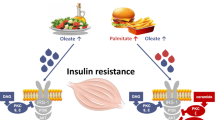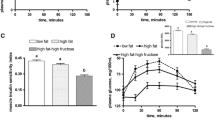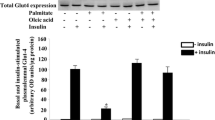Abstract
Purpose
Industrial trans fatty acid (TFA) intake leads to impaired glucose metabolism. However, the overall effects reported are inconsistent and vary with the dietary FA composition and TFA isomer type and levels. We investigated TFA effects on glucose uptake, incorporation and oxidation, and glycogen synthesis in incubated soleus muscle under basal conditions or after treatment with insulin and/or palmitate.
Methods
Male Wistar rats were fed either linoleic acid (LA)-enriched (+LA) or LA-deprived (−LA) diet, supplemented (+LA + TFA or −LA + TFA) or not with TFA, for 60 days. Soleus muscle glucose metabolism was assessed in the absence or presence of insulin and/or palmitic acid.
Results
Under basal conditions, TFA enhanced glucose uptake and oxidation regardless of the LA status. Both TFA-supplemented groups had lower insulin response to glucose metabolism. Under insulin-stimulated conditions, TFA prevented the palmitate inhibition of muscle glucose uptake and metabolism in the +LA + TFA group.
Conclusion
Dietary TFA enhanced glucose utilization in incubated soleus muscle under basal conditions and prevented the palmitate-induced inhibition in insulin-stimulated conditions. However, TFA reduced the insulin response to glucose uptake and metabolism. The effects mentioned above were influenced by the FA profile modifications induced by the dietary LA levels, suggesting that lipid metabolization and incorporation into plasma membrane are important determining factors of glucose metabolism and insulin sensitivity.




Similar content being viewed by others
References
Fedacko J, Vargova V, Singh RB, Anjum B (2012) Association of high w-6 / w-3 fatty acid ratio diet with causes of death due to noncommunicable diseases among urban decedents in north India. Open Nutraceuticals J 5:113–123
Lee JH, Fukumoto M, Nishida H, Ikeda I, Sugano M (1989) The interrelated effects of n-6/n-3 and polyunsaturated/saturated ratios of dietary fats on the regulation of lipid metabolism in rats. J Nutr 119:1893–1899
Broughton KS, Wade JW (2002) Total fat and (n-3):(n-6) fat ratios influence eicosanoid production in mice. J Nutr 132:88–94
Igarashi M, Gao F, Kim HW, Ma K, Bell JM, Rapoport SI (2009) Dietary n-6 PUFA deprivation for 15 weeks reduces arachidonic acid concentrations while increasing n-3 PUFA concentrations in organs of post-weaning male rats. Biochim Biophys Acta 1791:132–139
Allmann DW, Gibson DM (1965) Fatty acid synthesis during early linoleic acid deficiency in the mouse. J Lipid Res 6:51–62
Colandre ME, Diez RS, Bernal CA (2003) Metabolic effects of trans fatty acids on an experimental dietary model. Br J Nutr 89:631–639
Dorfman SE, Laurent D, Gounarides JS, Li X, Mullarkey TL, Rocheford EC, Sari-Sarraf F, Hirsch EA, Hughes TE, Commerford SR (2009) Metabolic implications of dietary trans-fatty acids. Obesity (Silver Spring) 17:1200–1207
Bernal CA, Rovira J, Colandre ME, Cusso R, Cadefau JA (2006) Effects of dietary cis and trans unsaturated and saturated fatty acids on the glucose metabolites and enzymes of rats. Br J Nutr 95:947–954
Fariña AC, González MA, Scalerandi MV, Bernal CA (2015) Effect of trans fatty acids on the nutritional status and lipid metabolism in rats fed linoleic acid enriched and deficient diets. Eur J Lipid Sci Technol 117:933–944
Ibrahim A, Natrajan S, Ghafoorunissa R (2005) Dietary trans-fatty acids alter adipocyte plasma membrane fatty acid composition and insulin sensitivity in rats. Metabolism 54:240–246
Silveira Osso F, Bello Moreira AS, Teixeira Teixeira M, Oliveira Pereira R, Tavares do Carmo MG, Sanchez Moura A (2008) Trans fatty acids in maternal milk lead to cardiac insulin resistance in adult offspring. Nutrition 24(7–8):727–732
Kavanagh K, Jones KL, Sawyer J, Kelley K, Carr JJ, Wagner JD, Rudel LL (2007) Trans fat diet induces abdominal obesity and changes in insulin sensitivity in monkeys. Obesity 15:1675–1684
Ryder JW, Portocarrero CP, Song XM, Cui L, Yu M, Combatsiaris T, Galuska D, Bauman DE, Barbano DM, Charron MJ, Zierath JR, Houseknecht KL (2001) Isomer-specific antidiabetic properties of conjugated linoleic acid. Improved glucose tolerance, skeletal muscle insulin action, and UCP-2 gene expression. Diabetes 50:1149–1157
Fariña AC, Hirabara S, Sain J, Latorre ME, González MA, Curi R, Bernal CA (2014) Conjugated linoleic acid improves glucose utilization in the soleus muscle of rats fed linoleic acid-enriched and linoleic acid-deprived diets. Nutr Res 34(1092):1100
Houseknecht KL, Vanden Heuvel JP, Moya-Camarena SY, Portocarrero CP, Peck LW, Nickel KP, Belury MA (1998) Dietary conjugated linoleic acid normalizes impaired glucose tolerance in the Zucker diabetic fatty fa/fa rat. Biochem Biophys Res Commun 244:678–682
Choi JS, Jung MH, Park HS, Song J (2004) Effect of conjugated linoleic acid isomers on insulin resistance and mRNA levels of genes regulating energy metabolism in high-fat-fed rats. Nutrition 20:1008–1017
Choi JS, Koh IU, Jung MH, Song J (2007) Effects of three different conjugated linoleic acid preparations on insulin signalling, fat oxidation and mitochondrial function in rats fed a high-fat diet. Br J Nutr 98:264–275
Natarajan S, Ibrahim A (2005) Dietary trans fatty acids alter diaphragm phospholipid fatty acid composition, triacylglycerol content and glucose transport in rats. Br J Nutr 93:829–833
Sakamoto K, Holman GD (2008) Emerging role for AS160/TBC1D4 and TBC1D1 in the regulation of GLUT4 traffic. Am J Physiol Endocrinol Metab 295:E29–E37
Hirabara SM, Curi R, Maechler P (2010) Saturated fatty acid-induced insulin resistance is associated with mitochondrial dysfunction in skeletal muscle cells. J Cell Physiol 222:187–194
Roden M (2004) How Free Fatty Acids Inhibit Glucose Utilization in Human Skeletal Muscle. Physiology 19(3):92–96
Randle PJ, Garland PB, Hales CN, Newsholme EA (1963) The glucose fatty-acid cycle. Its role in insulin sensitivity and the metabolic disturbances of diabetes mellitus. The Lancet 1:785–789
Hirabara SM, Gorjao R, Vinolo MA, Rodrigues AC, Nachbar RT, Curi R (2012) Molecular targets related to inflammation and insulin resistance and potential interventions. J Biomed Biotechnol 2012:379024
Hill EG, Johnson SB, Holman RT (1979) Intensification of essential fatty acid deficiency in the rat by dietary trans fatty acids. J Nutr 109:1759–1765
Hill EG, Johnson SB, Lawson LD, Mahfouz MM, Holman RT (1982) Perturbation of the metabolism of essential fatty acids by dietary partially hydrogenated vegetable oil. Proc Natl Acad Sci U S A 79:953–957
Privett OS, Phillips F, Shimasaki H, Nozawa T, Nickell EC (1977) Studies of effects of trans fatty acids in the diet on lipid metabolism in essential fatty acid deficient rats. Am J Clin Nutr 30:1009–1017
Bayne K (1996) Revised Guide for the Care and Use of Laboratory Animals available. American Physiological Society. Physiologist 39:199, 208–199, 211
Reeves PG, Nielsen FH, Fahey GC Jr (1993) AIN-93 purified diets for laboratory rodents: final report of the American Institute of Nutrition ad hoc writing committee on the reformulation of the AIN-76A rodent diet. J Nutr 123:1939–1951
Report of the American Institute of Nutrition Ad Hoc Committee on Standards for Nutritional Studies (1977) J Nutr 107:1340–1348
Bligh EG, Dyer WJ (1959) A rapid method of total lipid extraction and purification. Can J Biochem Physiol 37:911–917
ISO 5509(E) (2000) Animal and vegetable fats and oils. Preparation of methyl esters of fatty acids
AOCS Official Method Ce 1j-07 (2007) Official methods and recommended practices of the AOCS, 6th edition, AOCS, Champaign
Fariña AC, González MA, Latorre ME, Bernal CA (2013) Efectos de los conjugados del ácido linoleico sobre la incorporación tisular de ácidos grasos y metabolismo lipídico en ratas deficientes en ácidos grasos esenciales. FABICIB 17, 85–112
Warensjo E, Riserus U, Gustafsson IB, Mohsen R, Cederholm T, Vessby B (2008) Effects of saturated and unsaturated fatty acids on estimated desaturase activities during a controlled dietary intervention. Nutr Metab Cardiovasc Dis 18:683–690
Crettaz M, Prentki M, Zaninetti D, Jeanrenaud B (1980) Insulin resistance in soleus muscle from obese Zucker rats. Involvement of several defective sites. Biochem J 186:525–534
Massao HS, de Oliveira Carvalho CR, Mendonca JR, Piltcher HE, Fernandes LC, Curi R (2003) Palmitate acutely raises glycogen synthesis in rat soleus muscle by a mechanism that requires its metabolization (Randle cycle). FEBS Lett 541:109–114
Challiss RA, Espinal J, Newsholme EA (1983) Insulin sensitivity of rates of glycolysis and glycogen synthesis in soleus, stripped soleus, epitrochlearis, and hemi-diaphragm muscles isolated from sedentary rats. Biosci Rep 3:675–679
Thompson AL, Lim-Fraser MY, Kraegen EW, Cooney GJ (2000) Effects of individual fatty acids on glucose uptake and glycogen synthesis in soleus muscle in vitro. Am J Physiol Endocrinol Metab 279:E577–E584
Leighton B, Budohoski L, Lozeman FJ, Challiss RA, NEWSHOLME EA (1985) The effect of prostaglandins E1, E2 and F2 alpha and indomethacin on the sensitivity of glycolysis and glycogen synthesis to insulin in stripped soleus muscles of the rat. Biochem J 227:337–340
Espinal J, Dohm GL, NEWSHOLME EA (1983) Sensitivity to insulin of glycolysis and glycogen synthesis of isolated soleus-muscle strips from sedentary, exercised and exercise-trained rats. Biochem J 212:453–458
DeGroot M (1986) Probability and statistics. Addison-Wesley Publishing Company, Reading
Lovejoy JC, Smith SR, Champagne CM, Most MM, Lefevre M, DeLany JP, Denkins YM, Rood JC, Veldhuis J, Bray GA (2002) Effects of diets enriched in saturated (palmitic), monounsaturated (oleic), or trans (elaidic) fatty acids on insulin sensitivity and substrate oxidation in healthy adults. Diabetes Care 25:1283–1288
Louheranta AM, Turpeinen AK, Vidgren HM, Schwab US, Uusitupa MI (1999) A high-trans fatty acid diet and insulin sensitivity in young healthy women. Metabolism 48:870–875
Simopoulos AP (1994) Is insulin resistance influenced by dietary linoleic acid and trans fatty acids? Free Radic Biol Med 17:367–372
de Santa Olalla LM, Sánchez Muniz FJ, Vaquero MP (2009) N-3 fatty acids in glucose metabolism and insulin sensitivity. Nutr Hosp 24:113–127
Lien EL, Boyle FG, Wrenn JM, Perry RW, Thompson CA, Borzelleca JF (2001) Comparison of AIN-76A and AIN-93G diets: a 13-week study in rats. Food Chem Toxicol 39:385–392
Pugh EL, Kates M (1984) The dietary regulation of acyltransferase and desaturase activities in microsomal membranes of rat liver. Lipids 19:48–55
Gibson RA, Neumann MA, Lien EL, Boyd KA, Tu WC (2013) Docosahexaenoic acid synthesis from alpha-linolenic acid is inhibited by diets high in polyunsaturated fatty acids. Prostaglandins Leukot Essent Fatty Acids 88:139–146
Brenner RR, Peluffo RO (1969) Regulation of unsaturated fatty acids biosynthesis. I. Effect of unsaturated fatty acid of 18 carbons on the microsomal desaturation of linoleic acid into gamma-linolenic acid. Biochim Biophys Acta 176:471–479
Larque E, Garcia-Ruiz PA, Perez-Llamas F, Zamora S, Gil A (2003) Dietary trans fatty acids alter the compositions of microsomes and mitochondria and the activities of microsome delta6-fatty acid desaturase and glucose-6-phosphatase in livers of pregnant rats. J Nutr 133:2526–2531
Kummerow FA, Zhou Q, Mahfouz MM, Smiricky MR, Grieshop CM, Schaeffer DJ (2004) Trans fatty acids in hydrogenated fat inhibited the synthesis of the polyunsaturated fatty acids in the phospholipid of arterial cells. Life Sci 74:2707–2723
Bhattacharya A, Rahman MM, Sun D, Lawrence R, Mejia W, McCarter R, O’Shea M, Fernandes G (2005) The combination of dietary conjugated linoleic acid and treadmill exercise lowers gain in body fat mass and enhances lean body mass in high fat-fed male Balb/C mice. J Nutr 135:1124–1130
Pisani LP, Oyama LM, Bueno AA, Biz C, Albuquerque KT, Ribeiro EB, Oller do Nascimento CM (2008) Hydrogenated fat intake during pregnancy and lactation modifies serum lipid profile and adipokine mRNA in 21-day-old rats. Nutrition 24:255–261
Alkhateeb H, Chabowski A, Glatz JF, Luiken JF, Bonen A (2007) Two phases of palmitate-induced insulin resistance in skeletal muscle: impaired GLUT4 translocation is followed by a reduced GLUT4 intrinsic activity. Am J Physiol Endocrinol Metab 293:E783–E793
Storlien LH, Baur LA, Kriketos AD, Pan DA, Cooney GJ, Jenkins AB, Calvert GD, Campbell LV (1996) Dietary fats and insulin action. Diabetologia 39(6):621–631
Schmitz-Peiffer C (2000) Signalling aspects of insulin resistance in skeletal muscle: mechanisms induced by lipid oversupply. Cell Signal 12:583–594
Andersson A, Nalsen C, Tengblad S, Vessby B (2002) Fatty acid composition of skeletal muscle reflects dietary fat composition in humans. Am J Clin Nutr 76:1222–1229
Cooney GJ, Thompson AL, Furler SM, Ye J, Kraegen EW (2002) Muscle long-chain acyl CoA esters and insulin resistance. Ann N Y Acad Sci 967:196–207
Dimopoulos N, Watson M, Sakamoto K, Hundal HS (2006) Differential effects of palmitate and palmitoleate on insulin action and glucose utilization in rat L6 skeletal muscle cells. Biochem J 399:473–481
Acknowledgements
We wish to thank Walter DaRú for his technical assistance. We also thank Universidad Nacional del Litoral-Cursos de Acción para la Investigación y Desarrollo (CAI + D 501 201101 00165 LI)-Secretaría de Ciencia y Técnica-UNL, Consejo Nacional de Investigaciones Científicas y Técnicas (PIP CONICET No. 112-200801-02831), FAPESP (Fundação de Amparo à Pesquisa do Estado de São Paulo) and CONICET Resol. No. 473/11, for their financial support to the collaborative research program between the Universidad Nacional del Litoral and the Universidade de São Paulo.
Author information
Authors and Affiliations
Corresponding author
Ethics declarations
Conflict of interest
There are no conflicts of interest in this study.
Ethical approval
The experimental procedures were approved by the Ethics Committee of the School of Biochemistry and by the Ethics Committee of the Institute of Biomedical Sciences, University of Sao Paulo. Both followed the Guide for the Care and Use of Laboratory Animals.
Additional information
Ana C. Fariña and Sandro Hirabara contributed equally to this work.
Rights and permissions
About this article
Cite this article
Fariña, A.C., Hirabara, S., Sain, J. et al. Influence of trans fatty acids on glucose metabolism in soleus muscle of rats fed diets enriched in or deprived of linoleic acid. Eur J Nutr 57, 1343–1355 (2018). https://doi.org/10.1007/s00394-017-1413-3
Received:
Accepted:
Published:
Issue Date:
DOI: https://doi.org/10.1007/s00394-017-1413-3




